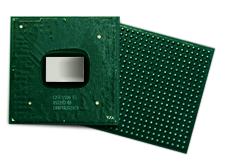
The VIA C7 processor combines exceptionally low power consumption with a host of unique technologies to maintain cool running and extend battery life. The enhanced VIA PowerSaver technology combines superior power management through defining intelligent power stage changes with ultra low power levels in sleep mode, while the advanced 90nm system-on-insulator (SOI) process allows unprecedented levels of integration within the tiny 30mm 2 processor die, permitting performance scalability and considerable feature additions while maintaining the signature low power draw of VIA processors.
The VIA C7-M processor is based on the advanced VIA CoolStream architecture of the ‘Esther' core that minimizes power consumption within an ultra compact die while optimizing performance, making it an ideal solution for a wide range of mobile systems, from extra slim personal laptops to mainstream corporate notebooks. Consuming as little as 100mW (0.1W) idle power and a maximum thermal design power (TDP) of around 20 watts at 2.0GHz, the VIA C7-M processor also features VIA PowerSaver technology to reduce processor power draw by as much as 50% to further extend battery life. With its low profile nanoBGA2 package measuring just 21mm x 21mm , the VIA C7-M has only minimal active cooling requirements to enable designs with thinner and smaller components, reducing notebook weight and thickness.
Initially available at speeds of 1.5GHz+, the VIA C7-M processor comprises a host of performance features such as StepAhead™ Advanced Branch Prediction, sixteen pipeline stages, support for SSE2 and the advanced SSE3 multimedia 3D instruction sets, a full-speed Floating Point Unit (FPU) and an efficiency-enhanced 128KB full-speed exclusive L2 cache with 32-way associativity for memory optimization. Coupled with one of the VIA C-Series digital media chipsets, the VIA C7-M processor provides smooth playback of digital video and audio, and offers exceptional memory and peripheral support. The unique TwinTurbo PLL implementation acts like automatic transmission, permitting smooth transition between activity states to within one clock cycle, to ensure always-on service and minimize latency.
To enhance the confidentiality, integrity, and authenticity of electronic data for mobile users on the go, the VIA C7-M has augmented the industry-leading on-die hardware cryptographic acceleration features within the VIA PadLock Hardware Security Suite, adding SHA-1 and SHA-256 hashing for secure message digests for data integrity, and a hardware based Montgomery Multiplier supporting key sizes up to 32K in length to accelerate public key cryptography, such as RSA™, to the world's best random number generator (RNG) and AES Encryption Engine in the previous processor generation. The VIA C7 also provides execute protection (NX), providing protection from malicious software such as worms and viruses, and is used in Microsoft Windows XP with SP2. Integrating security directly onto the processor die ensures speeds and efficiency many times that available in software, yet with negligible impact on processor performance.
The VIA C7-M processor is sampling now and will enter mass production at the end of Q2. Some photos of the presentation can be found at VIA Arena and details about the processor architecture can be found at VIA's website.